Species Diversity in the Leafhopper Genus Batracomorphus Lewis (Hemiptera: Cicadellidae: Iassinae) from Qinling Mountain in Shaanxi
Abstract
Simple Summary
Abstract
1. Introduction
2. Materials and Methods
3. Results and Discussion
3.1. Generic Character
3.2. Overview of Species Identification, Distribution
3.2.1. Checklist of the Species of Batracomorphus from China
- Batracomorphus allionii (Turton) China (Heilongjiang, Jilin, Liaoning, Inner Mongolia, Shaanxi, Zhejiang, Henan, Hubei, Anhui, Shandong, Yunnan, Guizhou, Sichuan), Austria, Azerbaijan, Belgium, Czech, Slovakia, Denmark, Finland, France, Germany, Italy, Kazakhstan, Latvia, Lithuania, Mongolia, Netherlands, Norway, Poland, Romania, Russia, Spain, United Kingdom, Ukraine.
- Batracomorphus chlorophana (Melichar) China (Guizhou, Taiwan, Hubei), Africa, Borneo, Burma, India, Java, Marquesas Islands, Philippines, Samoa, Sri Lanka, West Malaysia.
- Batracomorphus clavatus Shen and Cai China (Shaanxi, Henan).
- Batracomorphus cornutus Li China (Hainan).
- Batracomorphus dentestyleus Li China (Yunnan).
- Batracomorphus expansus (Li and Wang) China (Guizhou).
- Batracomorphus extentus Cai and He China (Zhejiang).
- Batracomorphus fletcheri Hu and Dai sp. nov. China (Shaanxi, Zhejiang).
- Batracomorphus furcatus Li China (Yunnan, Guizhou).
- Batracomorphus fuscomaculatus (Kuoh) China (Yunnan, Guizhou).
- Batracomorphus geminatus (Li and Wang) China (Shaanxi, Guizhou, Hainan).
- Batracomorphus gracilidensus Li China (Hainan).
- Batracomorphus gracilis Li China (Xinjiang).
- Batracomorphus guzhangensis Li China (Hunan).
- Batracomorphus imitans Jacobi China (Fujian).
- Batracomorphus inachus Knight China (Henan), Philippines.
- Batracomorphus indicus (Lethierry) China (Hubei, Sichuan, Yunnan, Taiwan), Philippines, Sri Lanka, India, Myanmar, Burma, Flores, Krakatau, Lombok, Seychelles, Sumbawa.
- Batracomorphus irroratus Lewis China, Afghanistan, Albania, Armenia, Austria, Azerbaijan, Belgium, Bohemia, Bulgaria, Czechia, Slovak, Denmark, France, Georgia, Germany, Greece, Hungary, Italy, Kazakhstan, Kyrgyzstan, Lithuania, Moldova, Mongolia, Moravia, Poland, Russia, Serbia, Slovakia, Switzerland, Tajikistan, Turkey, Turkmenia, Ukraine, United Kingdom, Uzbekistan.
- Batracomorphus juno Knight, 1983 rec. nov. China (Shaanxi, Guizhou), Philippines, Borneo, and West Malaysia.
- Batracomorphus laminocus Cai and He China (Zhejiang).
- Batracomorphus lateprocessus Li China (Shaanxi, Zhejiang, Hunan).
- Batracomorphus lineatus Shen and Cai China (Henan).
- Batracomorphus lunatus Cai and He China (Guizhou, Shaanxi, Zhejiang).
- Batracomorphus matsumurai (Metcalf) China (Zhejiang, Hennan, Guizhou, Sichuan, Taiwan), Japan, North Korea.
- Batracomorphus notatus (Kuoh) China (Yunnan, Guizhou).
- Batracomorphus pandarus Knight China (Xinjiang, Shaanxi,), Borneo.
- Batracomorphus paradentatus (Li and Wang) China (Yunnan, Guizhou).
- Batracomorphus pianmaensis Li China (Yunnan).
- Batracomorphus punctatus Li and Wang China (Guizhou).
- Batracomorphus reflexus (Kuoh) China (Yunnan).
- Batracomorphus rinkihonis (Matsumura) China (Zhejiang, Henan, Taiwan).
- Batracomorphus spadix Shen and Cai China (Henan).
- Batracomorphus strictus Li China (Hainan, Guizhou).
- Batracomorphus subfuscus (Li and Wang) China (Shaanxi, Henan, Guizhou, Zhejiang).
- Batracomorphus trifurcatus Li China (Hainan, Zhejiang, Guizhou).
- Batracomorphus viridulus (Melichar) China (Henan, Zhejiang, Sichuan, Yunnan, Huazhong), Japan, Korea.
- Batracomorphus xinxianensis Cai and Shen China (Henan).
3.2.2. Key to Species of Batracomorphus Based on Males from Qinling Mountain in Shaanxi, China
- -
- Aedeagus base strongly enlarged and expanded ventrally (Figure 10D), pygophore process nearly straight, thin (Figure 10A,B)………………B. lateprocessus Li and Wang
- -
- Aedeagus base not expanded ventrally, pygophore process not straight……………3
- Style internal rim serrated subapically (Figure 5D); pygophore process slightly bifid at apex (Figure 5C), aedeagus with rounded lateral flange at apex (Figure 5E) …………………………………………………………………………B. allionii (Turton)
- -
- Style internal rim not serrated subapically………………………………………………4
- Pygophore process with ventral rim serrate subapically, approximately as long as pygofer (Figure 7A,B); aedeagus concave in centre and oval in ventral view (Figure 7D).……………………….………………………………..……B. subfuscus (Li and Wang)
- -
- Pygophore process with ventral rim not serrated subapically…………………………5
- Style stout with subapical ridge, apex hooked laterad (Figure 6C); aedeagus shaft with lateral margins distinctly concave in ventral view (Figure 6F)….…B. pandarus Knight
- -
- Style with hooked apex, slightly expanded proximally (Figure 9C); pygophore process with small spine on ventral rim subapically, heel-like (Figure 9B); aedeagus shaft slender, apex transparent (Figure 9D,E)………………………………B. fletcheri sp. nov.
- -
- Style apex not hooked ………………………………………………………………………7
- Style apex bifid with finger-like lateral and triangular mesal projection (Figure 12C); pygophore process apex bifid with branches widely divergent (Figure 12B); aedeagus apex with triangular lateral extensions in ventral view (Figure 12D) …….………….…………………………………………………B. lunatus Cai and He
- -
- Style not bifid at apex, other features not as above………………………………………8
- Style broadened preapically then abruptly narrowed with apex hooked dorsally (Figure 8C); pygophore process sinuate, tapering to acute apex, with small teeth subapically (Figure 8B,E); aedeagus shaft evenly curved and tapered from base to apex in lateral view (Figure 8F)……………………………………………B. juno Knight rec. nov.
- -
3.2.3. Distribution
3.3. Species Description
3.3.1. Batracomorphus Allionii (Turton, 1802)
3.3.2. Batracomorphus pandarus Knight, 1983
3.3.3. Batracomorphus subfuscus (Li and Wang, 1993)
3.3.4. Batracomorphus juno Knight, 1983 rec. nov.
3.3.5. Batracomorphus fletcheri Hu and Dai sp. nov.
3.3.6. Batracomorphus Lateprocessus Li and Wang, 2003
3.3.7. Batracomorphus clavatus Cai and Shen, 2010
3.3.8. Batracomorphus lunatus Cai and He, 2001
3.3.9. Batracomorphus geminatus (Li and Wang, 1993)
4. Conclusions
Author Contributions
Funding
Institutional Review Board Statement
Data Availability Statement
Acknowledgments
Conflicts of Interest
References
- Oman, P.W.; Knight, W.J.; Nielson, M.W. Leafhoppers (Cicadellidae): A Bibliography, Generic Check-List and Index to the World Literature 1956–1985; CAB International Institute of Entomology: Wallingford, UK, 1990; p. 368. [Google Scholar]
- Dietrich, C.H. Keys to the families of Cicadomorpha and subfamilies and tribes of Cicadellidae (Hemiptera: Auchenorrhyncha). Fla. Entomol. 2005, 88, 502–517. [Google Scholar] [CrossRef]
- Dai, W.; Zhang, X.; Zhang, Y.; Dietrich, C.H. A new Oriental genus of Iassini leafhoppers (Hemiptera: Cicadellidae: Iassinae) with description of four new species. Zootaxa 2010, 2641, 15–26. [Google Scholar] [CrossRef]
- Dai, W.; Dietrich, C.H.; Zhang, Y. A review of the leafhopper tribe Hyalojassini (Hemiptera: Cicadellidae: Iassinae) with description of new taxa. Zootaxa 2015, 3911, 1–42. [Google Scholar] [CrossRef] [PubMed][Green Version]
- Krishnankutty, S.M.; Dietrich, C.H.; Dai, W.; Siddappaji, M.H. Phylogeny and historical biogeography of leafhopper subfamily Iassinae (Hemiptera: Cicadellidae) with a revised tribal classification based on morphological and molecular data. Syst. Entomol. 2016, 41, 580–595. [Google Scholar] [CrossRef]
- Lewis, R.H. Descriptions of some new genera of British Homoptera. Trans. Entomol. Soc. 1834, 1, 47–52. [Google Scholar] [CrossRef]
- Quartau, J.A.; Davies, R.G. A comparison of different numerical methods applied to the taxonomy of Batracomorphus Lewis (Insecta, Homoptera, Cicadellidae, Iassinae): Cluster analysis. Rev. Biol. 1981, 16, 550–594. [Google Scholar]
- Knight, W.J. The leafhopper genus Batracomorphus (Cicadellidae, Iassinae) in the eastern Oriental and Australian regions. Bull. Br. Mus. (Nat. Hist.) Entomol. 1983, 47, 27–210. [Google Scholar]
- Liang, A.P.; Cai, P.; Kuoh, C.L.; He, J.H. Homoptera: Cicadellidae. In Insects of the Three Gorge Reservoir area of Yangtze River; Yang, X.K., Ed.; Chongqing Publishing House: Chongqing, China, 1997; pp. 324–348. [Google Scholar]
- Yan, J.H.; Li, H.J.; Peng, H.Y.; Zhou, X.Z.; Gao, B.D. Bionomics of Batracomorphus dentatus and its control. Chin. Bull. Entomol. 2006, 43, 562–566. [Google Scholar]
- Wang, S.S.; Li, J.; Li, K.Y.; Wang, P.L.; Li, G.Y. A new Chinese record species of leafhoppers from wine grapes in Xinjiang. Plant Prot. 2010, 36, 168–171. [Google Scholar]
- Grylls, N.E. Leafhopper vectors and the plant disease agents they transmit in Australia. In Leafhopper Vectors and Plant Disease Agents; Maramorosch, K., Harris, K.F., Eds.; Academic Press: New York, NY, USA; San Francisco, CA, USA; London, UK, 1979; Volume I-XVI, pp. 179–214. [Google Scholar]
- Osmelak, J.A.; Emmett, R.W.; Pywell, M. Monitoring for potential leafhopper vectors (Hemiptera: Cicadelloidea and Fulgoroidea) of the causal agent of Australian grapevine yellows. Plant Prot. Q. 1989, 4, 8–10. [Google Scholar]
- Linnavuori, R.E.; Quartau, J.A. Revision of the Ethiopian Cicadellidae (Hemiptera-Homoptera): Iassinae and Acroponinae. Foundation pour favoriser les recherches scientifiquesen Afrique. Etudes Cont. Afr. 1975, 3, 1–170. [Google Scholar]
- Quartau, J.A. On some numerical methods applied to the taxonomy of some leafhoppers (Homoptera, Cicadellidae): An empirical investigation and critical appraisal. Acta Ent. Fenn. 1981, 38, 30–41. [Google Scholar]
- Evans, J.W. Some leafhoppers from New Guinea, Australia and Thailand belonging to the subfamily Jassinae and a new genus from New Guinea referred to a new subfamily the Acostermminae (Homoptera: Cicadellidae). Pac. Insects 1972, 14, 647–667. [Google Scholar]
- McBeath, J.; McBeath, J.H. Biodiversity conservation in China: Policies and practice. J. Internation. Wildlife Law Policy 2006, 9, 293–317. [Google Scholar] [CrossRef]
- Li, Z.Z.; Wang, L.M. Five new species of the genus Iassus from Guizhou province, China (Homoptera, Iassidae). Zool. Res. 1993, 14, 15–20. [Google Scholar]
- Li, Z.Z.; Wang, L.M. Notes on Chinese species of Batracomorphus Lewis with descriptions of seven new species (Homoptera, Cicadellidae, Iassinae). Acta Entomol. Sin. 2003, 28, 130–136. [Google Scholar]
- Kuoh, C.L. Five new species of the genus Iassus. Acta Zootaxonomica Sin. 1986, 11, 80–85. [Google Scholar]
- Cai, P.; Shen, X.L. Three new species of the genus Batracomorphus Lewis (Hemiptera: Cicadellidae: Iassinae) from China. Entomotaxonomia 2010, 32, 13–19. [Google Scholar]
- Yang, X.K. Insect Fauna of Middle-West Qinling Range and South Mountains of Gansu Province; Science Press: Beijing, China, 2005; p. 1055. [Google Scholar]
- Yang, X.K. Insect Fauna of the Qinling Mountains; World Publishing Corporation: Xi’an, China, 2018; p. 684. [Google Scholar]
- Cui, J.Z.; Bai, M.; Fan, R.J.; Wu, H. Catalogue of the Insect Type Specimens Deposited in China; China Forestry Publishing House: Beijing, China, 2009; Volume 2, p. 653. [Google Scholar]
- Cui, J.Z.; Bai, M.; Wu, H.; Ji, L.Q. Catalogue of the Insect Type Specimens Deposited in China; China Forestry Publishing House: Beijing, China, 2007; Volume 1, p. 792. [Google Scholar]
- Bai, M.; Cui, J.Z.; Hu, J.Y.; Li, L.Z. Catalogue of the Insect Type Specimens Deposited in China; China Forestry Publishing House: Beijing, China, 2014; Volume 3, p. 277. [Google Scholar]
- Fabricius, J.C. Ryngota. Entomologia systematica emendata et aucta: Secundun classes, ordines, genera, species, adjectis synonimis, locis, observationibus, descriptionibus. Impensis Christ. Gottl. Proft. Hafniae 1794, 4, 1–472. [Google Scholar]
- Turton, W. Order II. Hemiptera. Translated from Gmelin’s last edition of Systema Naturae, by Sir Charles Linne. Amended and enlarged by the improvements and discoveries of later naturalists and societies, Holmiae. Impensis Laurentii Salvii 1802, 2, 1–719. [Google Scholar]
- Latreille, P.A. Division seconde. Famille quarante-huitième. Cicadaires; Cicadariae. Histoire naturelle, générale et particulière des Crustacés et des Insectes: Ouvrage faisant suite aux oeuvres de Leclerc de Buffon, et partie du cours complet d’histoire naturelle rédigé par C. S. Sonnini, membre de plusieurs Sociétés savantes. F. Dufart. Paris 1804, 12, 5–424. [Google Scholar]
- Germar, E.F. Bemerkungen über einige Gattungen der Cicadarien. Mag. Entomol. Halle 1821, 4, 1–106. [Google Scholar]
- Lindberg, H. Zur Kenntnis der Cicadinengattung Batracomorphus Lew. Not. Entomol. 1923, 3, 68–71. [Google Scholar]
- Ossiannilsson, F. The Auchenorrhyncha (Homoptera) of Fennoscandia & Denmark, Part 2: Families Cicadidae, Cercopidae, Membracidae, Cicadellidae, Deltocephalinae. Fauna Entomol. Scand. 1981, 7, 223–593. [Google Scholar]
- Jacobi, A. Zur Kenntnis der Insekten von Mandschuko. 12. Beitrag. Eine Homopterenfaunula der Mandschurei. (Homoptera: Fulgoroidea, Cercopoidea & Jassoidea.). Arb. Morph. Tax. Entomol. Berlin-Dahlem. 1943, 10, 21–31. [Google Scholar]
- Ribaut, H. Homopters Auchenorhynques. II. (Jassidae). Fauna Fr. 1952, 57, 1–474. [Google Scholar]
- Metcalf, Z.P. New names in the Homoptera. J. Wash. Acad. Sci. 1955, 45, 262–267. [Google Scholar]
- Vilbaste, J. On Homoptera Cicadinea of Altais. Akademiya Nauk Estonskoï SSR; Institut Zoologii i Botaniki: Tartu, Estonia, 1965; p. 144. [Google Scholar]
- Metcalf, Z.P. General catalogue of the Homoptera. Fascicle VI. Cicadelloidea. Part 15. Iassidae; USDA: Washington, DC, USA, 1966; p. 229.
- Vilbaste, J. Contribution to the Auchenorrhyncha fauna of the Maritime Territeory; Valgus: Tallin, Estonia, 1968; p. 178, [Russian with German summary]. [Google Scholar]
- Nast, J. The Auchenorrhyncha (Homoptera) of Europe. Ann. Zool. Warszawa 1987, 40, 535–661. [Google Scholar]
- Anufriev, G.A.; Emeljanov, A.F. Suborder Cicadinea (Auchenorrhyncha). In A. Keys to the Insects of the Far East of the USSR; Ler, P.A., Ed.; Nauka: Leningrad, Russia, 1988; Volume 2, pp. 9–727. [Google Scholar]
- Cai, P.; Shen, X.C. Homoptera: Cicadellidae. In The Fauna and Taxonomy of Insects in Henan, Insects of the Mountains Funiu Regions; Shen, X.C., Shi, Z.Y., Eds.; China Agricultural Scientech Press: Beijing, China, 1998; Volume 2, pp. 242–250. [Google Scholar]
- Cai, P.; He, J.H.; Gu, X.L. Homoptera: Cicadellidae. In Insects of Tianmushan National Nature Reserve; Wu, H., Pan, C.W., Eds.; Science Press: Beijing, China, 2001; pp. 185–218. [Google Scholar]
- Nickel, H. The Leafhoppers and Planthoppers of Germany (Hemiptera, Auchenorrhyncha): Patterns and Startegies in a Highly Diverse Group of Phytophagous Insects; Pensoft: Sofia, Bulgaria; Moscow, Russia, 2003; pp. 1–460. [Google Scholar]
- Malenovsky, I.; Lauterer, P. Leafhoppers and planthoppers (Hemiptera: Auchenorrhyncha) of the Bílé Karpaty Protected Landscape Area and Biosphere Reserve (Czech Republic). Acta Musei Moraviae. Sci. Biol. (Brno) 2012, 96, 155–322. [Google Scholar]
- Dai, W.; Zhang, X.M.; Zhong, H.Y.; Wei, C.; Zhang, Y.L. Cicadellidae. In Insects in Helan Mountains of Inner Mongolia; Bai, X.S., Cai, W.Z., Nonnaizab, Eds.; Inner Mongolia People’s Publishing House: Inner Mongolia, China, 2013; pp. 147–158. [Google Scholar]
- Zhang, Y.L.; Lv, L.; Dai, W.; Huang, M.; Qing, D.Z.; Wei, C. Homoptera: Cicadellidae. In Fauna of Tianmu Mountain; Zhang, Y.L., Ed.; Zhejiang University Press: Hangzhou, China, 2017; Volume 4, pp. 70–205. [Google Scholar]
- Cai, P.; Shen, X.C. Homoptera: Cicadellidae. In The Fauna and Taxonomy of Insects in Henan, Insects of the Mountains Funiu and Dabie Regions; Shen, X.C., Pei, H.C., Eds.; China Agricultural Scientech Press: Beijing, China, 1999; Volume 4, pp. 36–44. [Google Scholar]
- Fang, Z.G.; Wu, H. A cheklist of insects from Zhejiang; China Forestry Press: Beijing, China, 2001; p. 452. [Google Scholar]
- Li, H.; Dai, R.H.; Li, Z.Z. Hemiptera: Cicadellidae: Iassinae and Macropsinae. In Insects from Kuankuoshui landscape; Dai, R.H., Li, Z.Z., Jin, D.C., Eds.; Guizhou Science and Technology Publishing House: Guiyang, China, 2012; pp. 192–198. [Google Scholar]
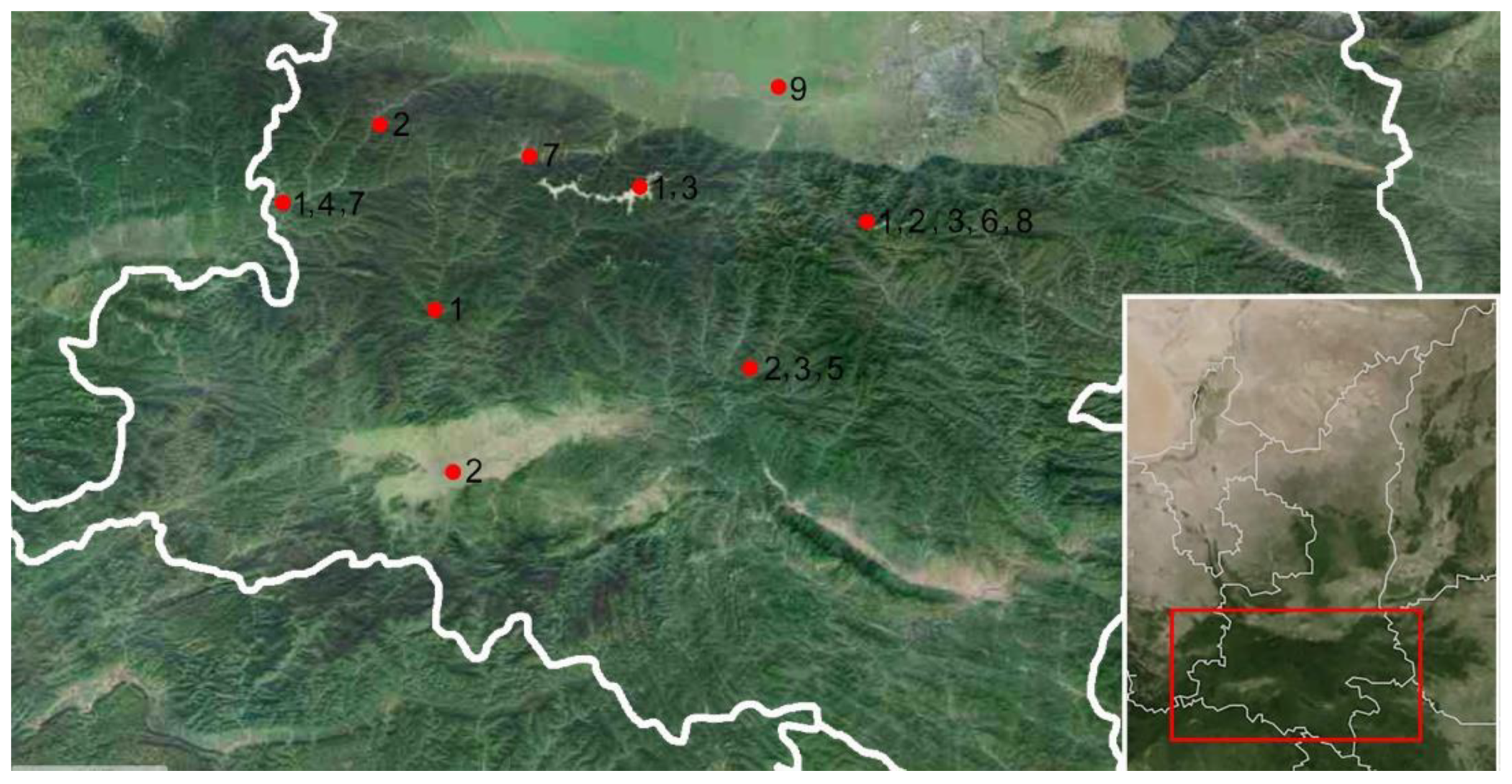
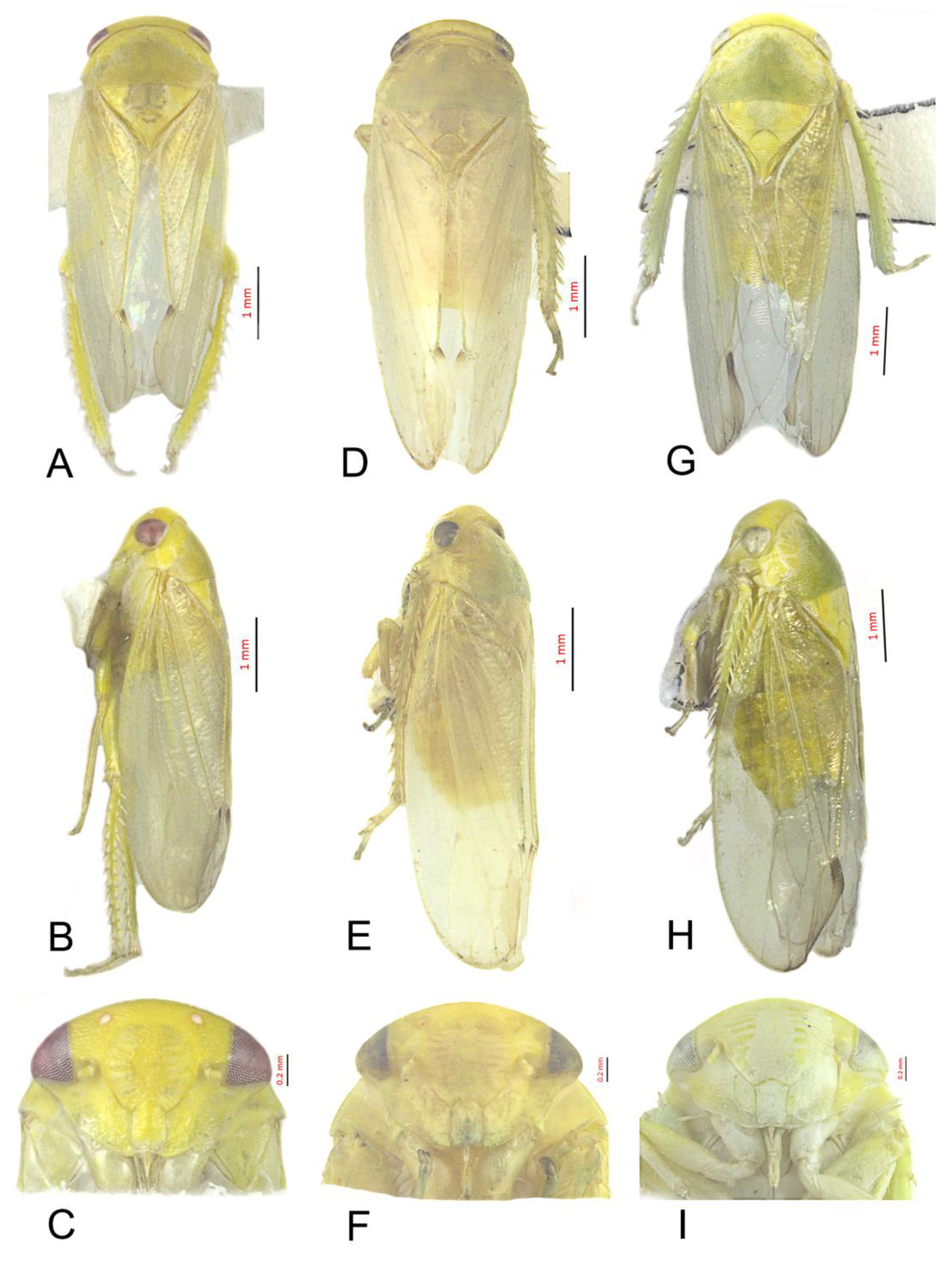
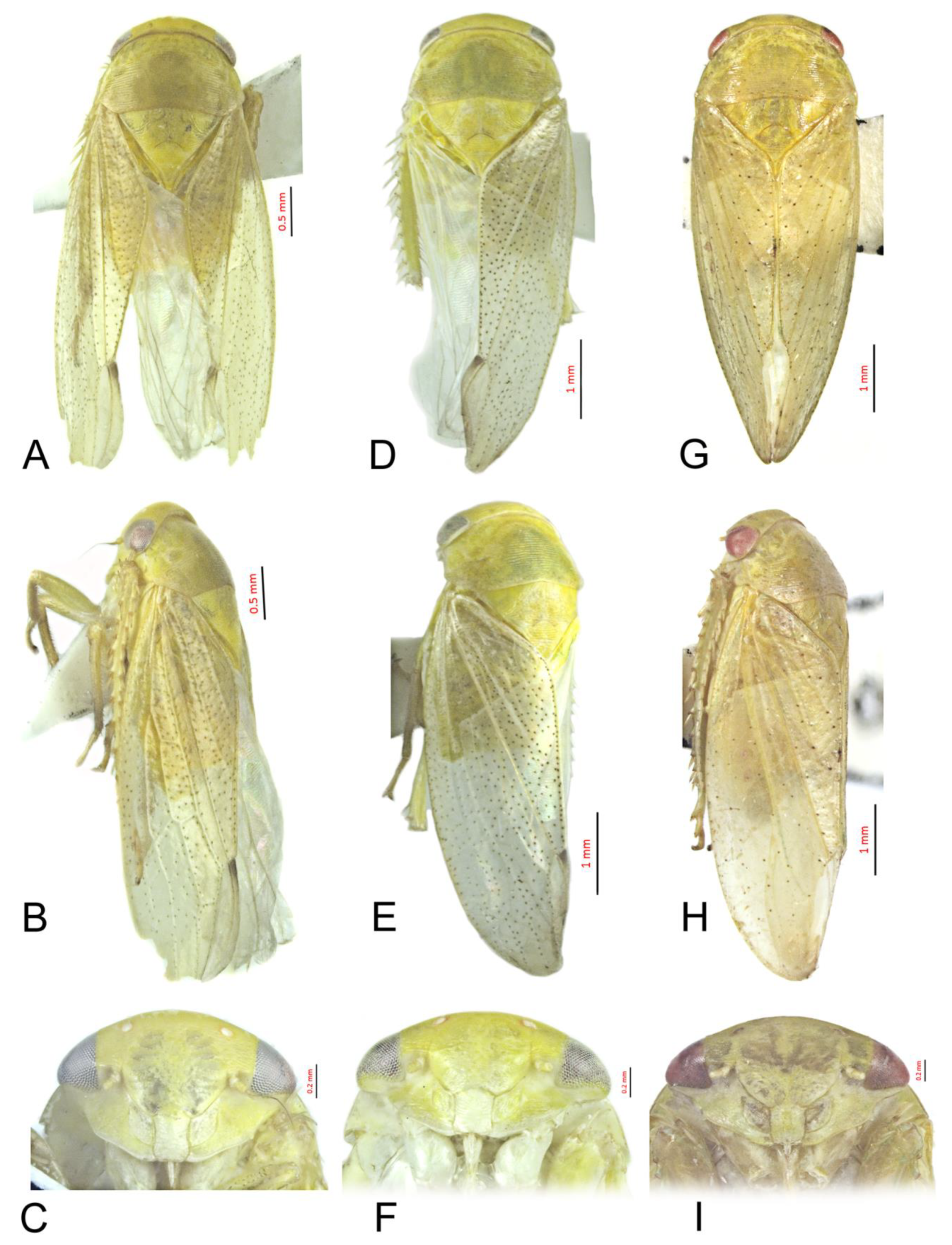
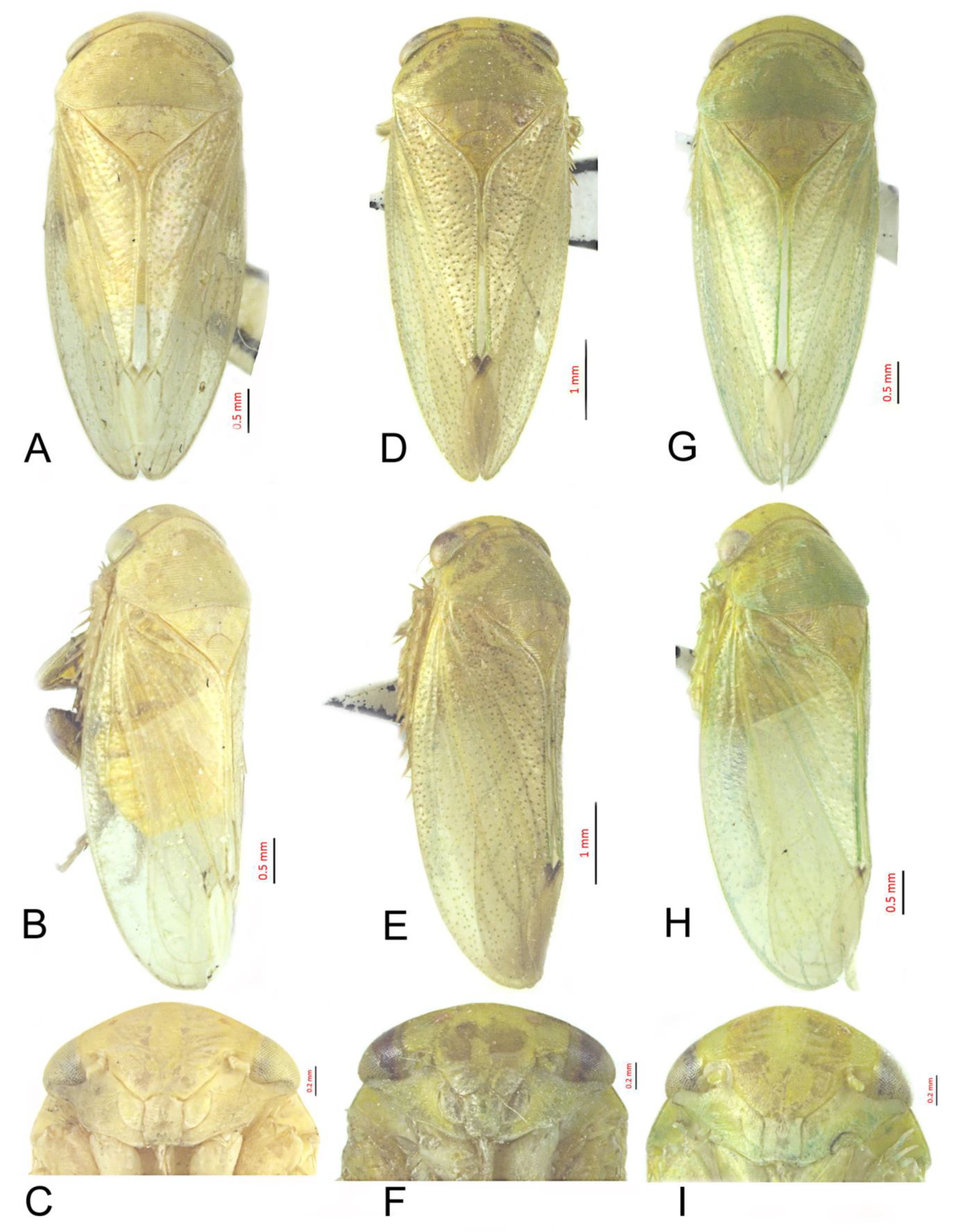
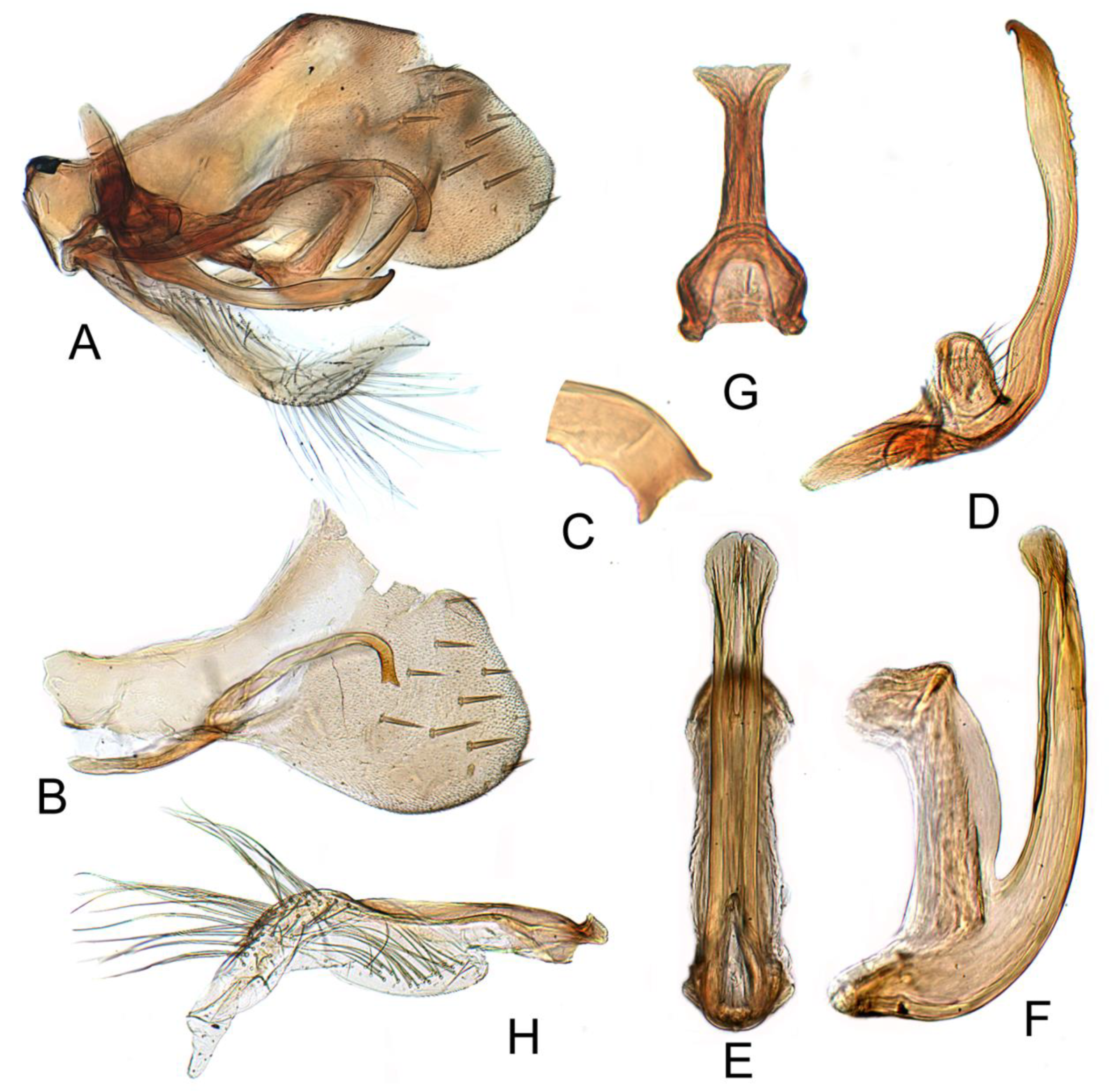

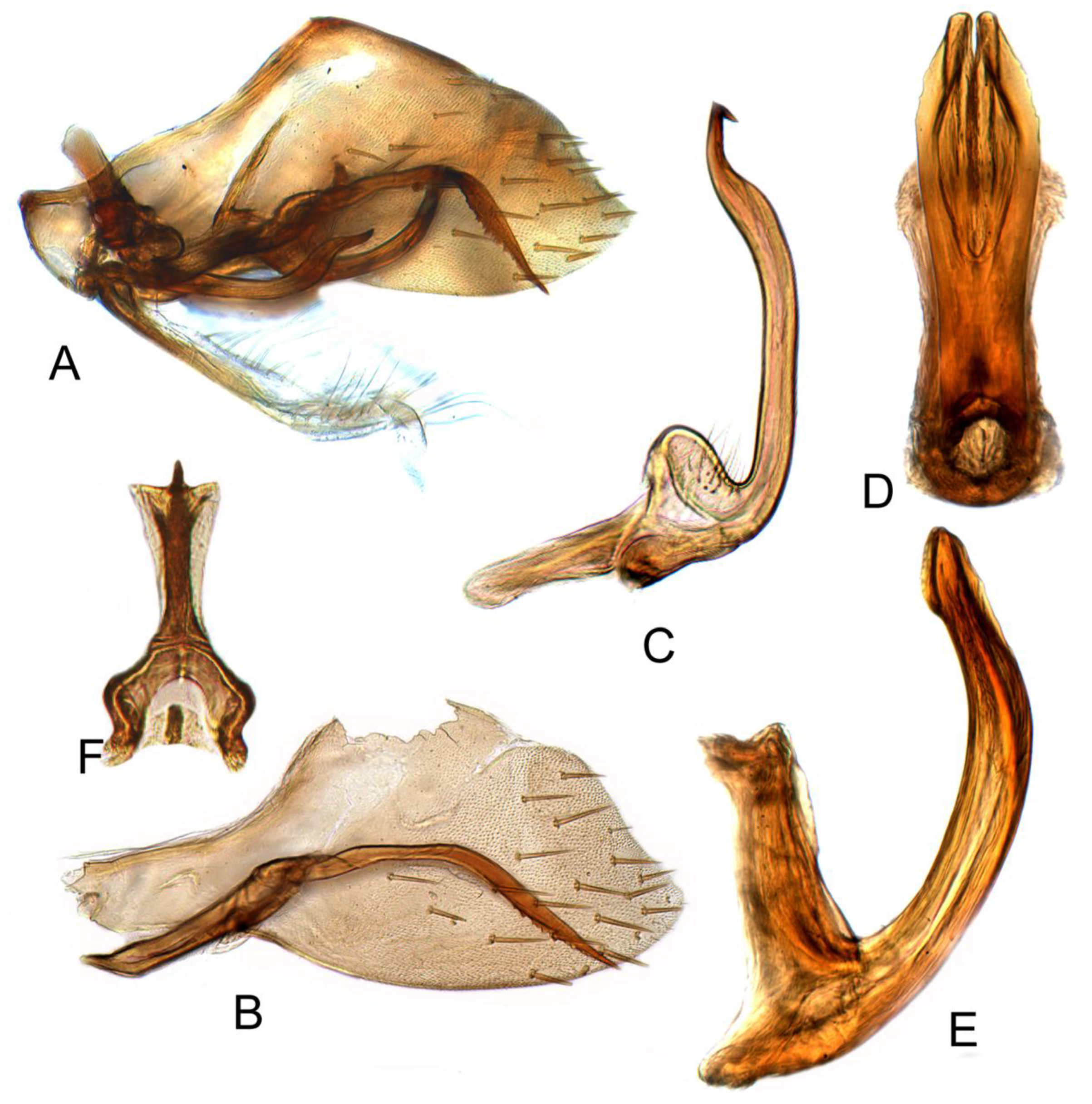
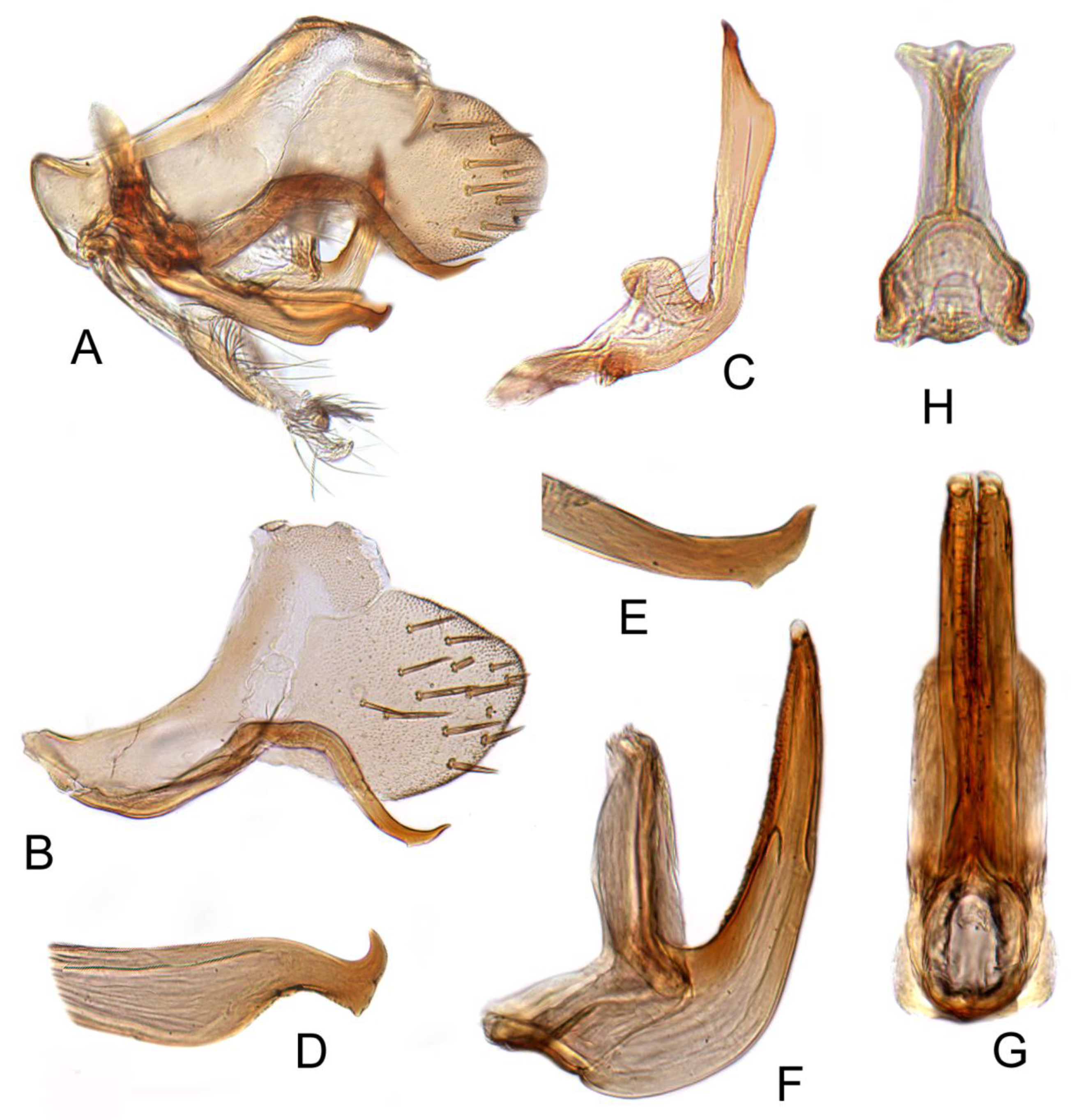
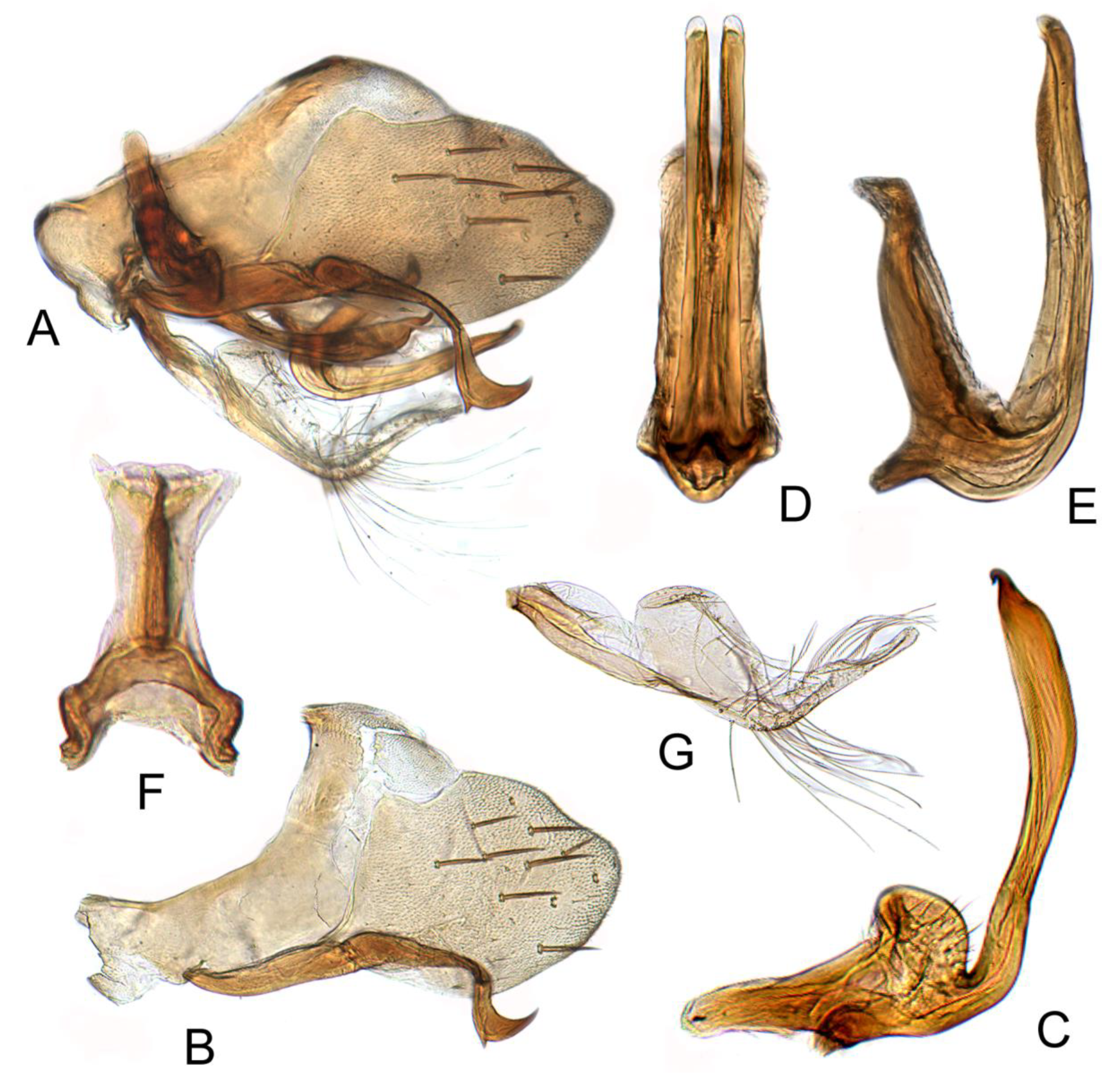
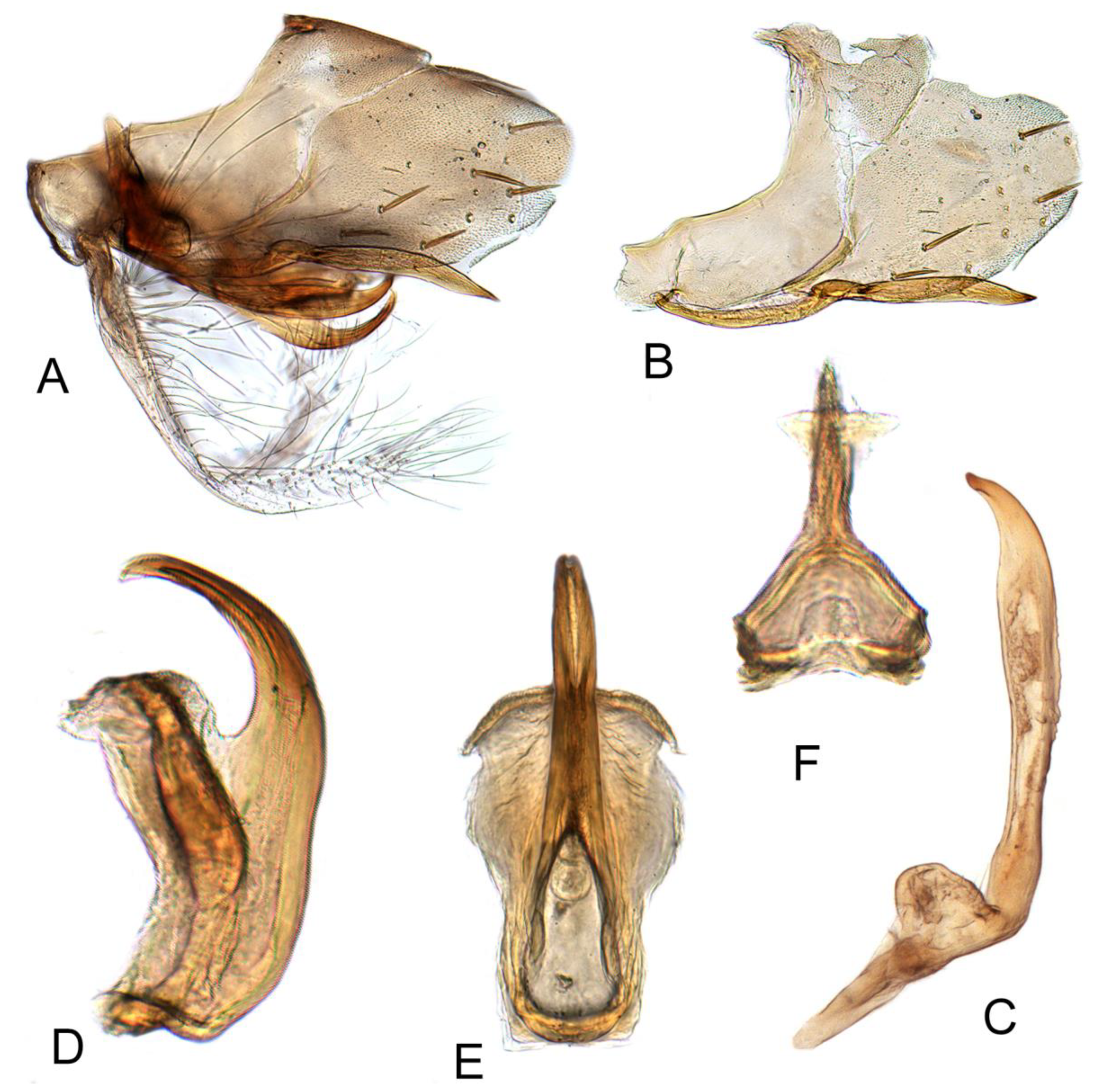
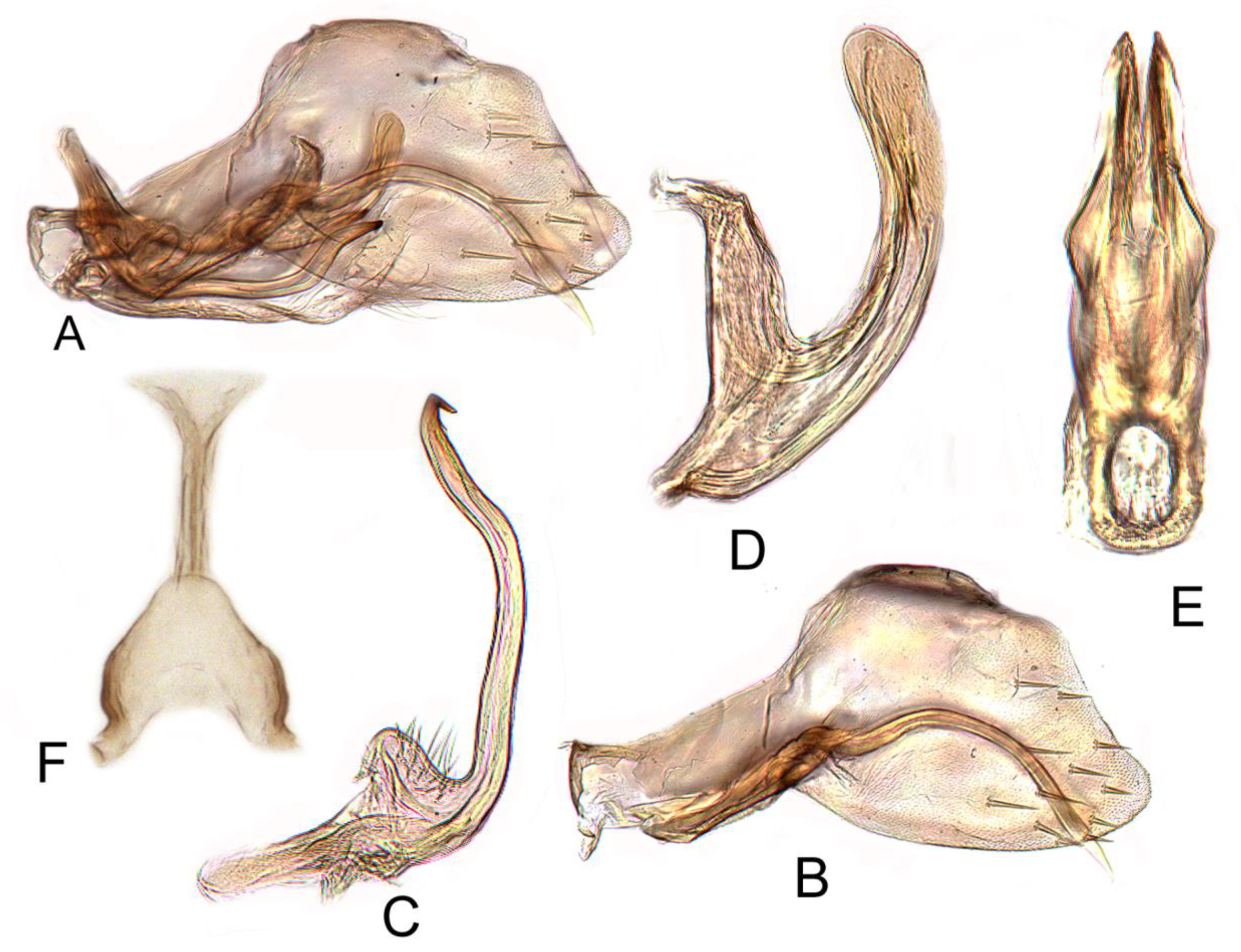
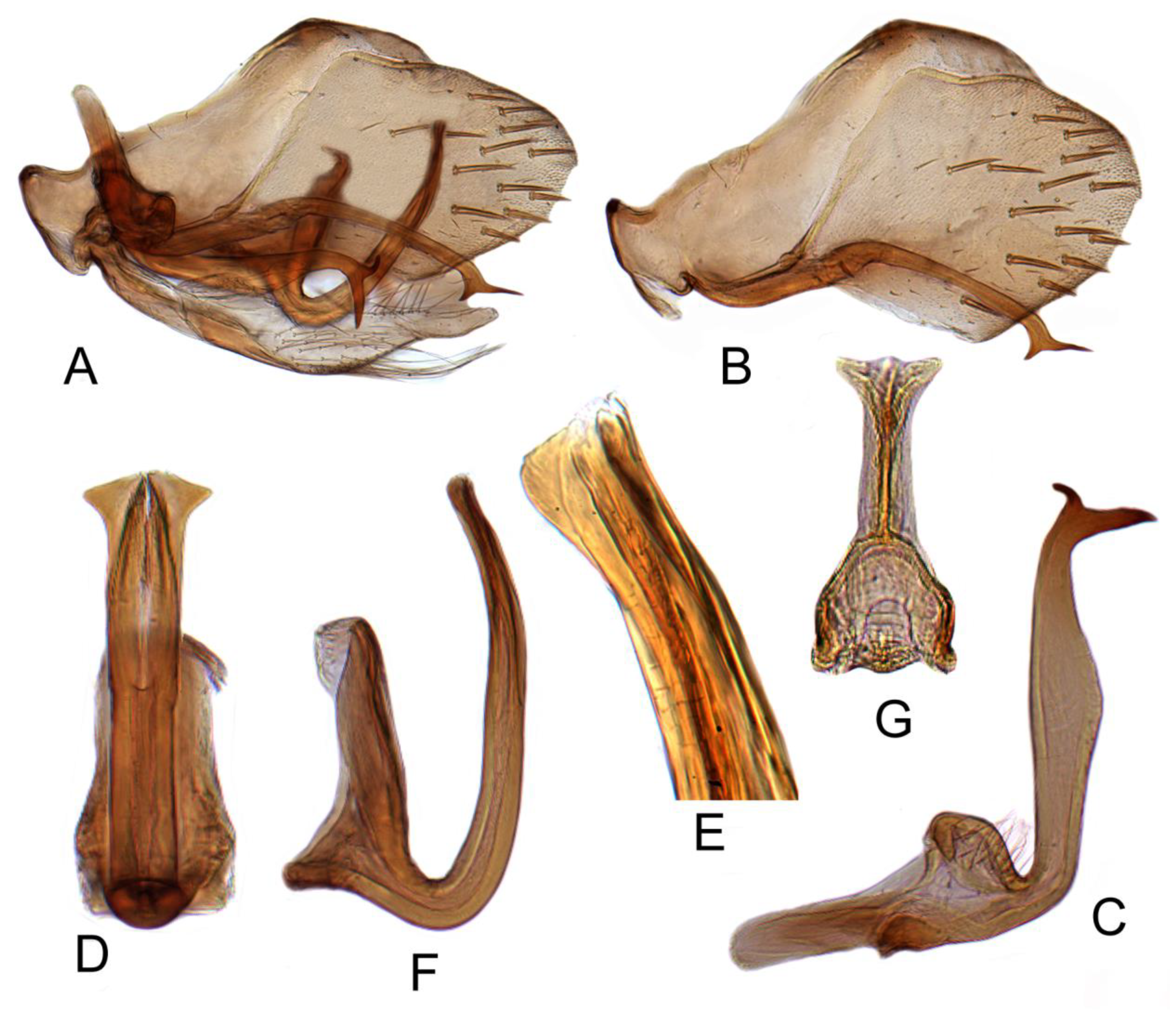

Publisher’s Note: MDPI stays neutral with regard to jurisdictional claims in published maps and institutional affiliations. |
© 2021 by the authors. Licensee MDPI, Basel, Switzerland. This article is an open access article distributed under the terms and conditions of the Creative Commons Attribution (CC BY) license (https://creativecommons.org/licenses/by/4.0/).
Share and Cite
Hu, Y.; Gao, L.; Han, Z.; Dai, W. Species Diversity in the Leafhopper Genus Batracomorphus Lewis (Hemiptera: Cicadellidae: Iassinae) from Qinling Mountain in Shaanxi. Insects 2021, 12, 494. https://doi.org/10.3390/insects12060494
Hu Y, Gao L, Han Z, Dai W. Species Diversity in the Leafhopper Genus Batracomorphus Lewis (Hemiptera: Cicadellidae: Iassinae) from Qinling Mountain in Shaanxi. Insects. 2021; 12(6):494. https://doi.org/10.3390/insects12060494
Chicago/Turabian StyleHu, Yulin, Lili Gao, Zihan Han, and Wu Dai. 2021. "Species Diversity in the Leafhopper Genus Batracomorphus Lewis (Hemiptera: Cicadellidae: Iassinae) from Qinling Mountain in Shaanxi" Insects 12, no. 6: 494. https://doi.org/10.3390/insects12060494
APA StyleHu, Y., Gao, L., Han, Z., & Dai, W. (2021). Species Diversity in the Leafhopper Genus Batracomorphus Lewis (Hemiptera: Cicadellidae: Iassinae) from Qinling Mountain in Shaanxi. Insects, 12(6), 494. https://doi.org/10.3390/insects12060494





